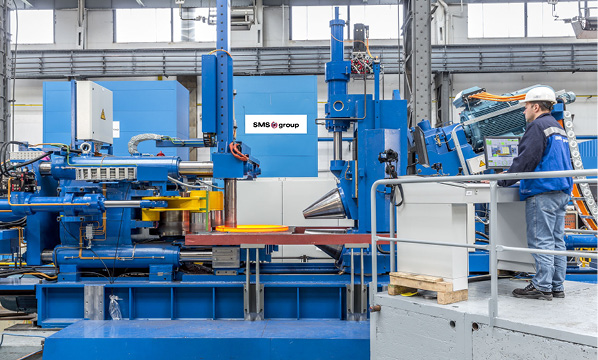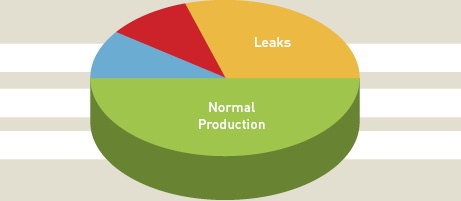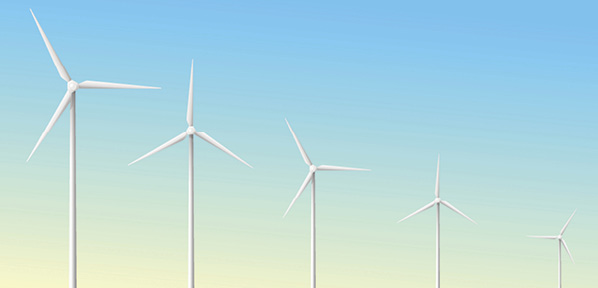Developing Electrohydrostatic Actuation to Improve Ring Rolling Production

By Dr. Erkhard Siemer, General Manager for Design Hydraulics and Electrical Engineering, SMS Group GmbH, and Achim Helbig, Dr.-Ing, Innovations Projects Manager, Moog Industrial Group
Moog’s new Electrohydrostatic Actuation System was developed jointly with SMS Group GmbH. In this interview, SMS’ Erkhard Siemer explains how the project evolved, and how the system has improved the group’s production performance.
Q: Last year, Moog launched its new Electrohydrostatic Actuation System (EAS). Moog developed the EAS in cooperation with the SMS Group, the company is a leader in manufacturing ring rolling mills. Could you tell us some of the background to this project please?
A: Prior to the development of the EAS, we operated our manufacturing machinery using a central hydraulic system, which featured a large oil tank and complex piping. This set up required significant and additional internal infrastructure – such as room space that housed our central hydraulics systems – near the machine operating area. This proved very costly for us, both financially and timewise.
Q: Can you say a little more about why this particular arrangement proved to be so expensive?
A: Our previous actuation system required central hydraulics storage facilities that proved to be inefficient in terms of energy, especially during part-load operation. For instance, the accumulator assisted hydraulic system made use of pumps that were constantly working against high pressure. High-resolution, dynamic servo hydraulics operated the rolling axes, and the power flow was controlled or throttled via the servo valve. As a result, some systemic throttling losses occurred, and these had a detrimental effect on the overall efficiency of the machine. Consequently, fast, rapid movements characterized our machine cycle, but these occurred without force, which resulted in slow high-resolution movements and high force levels with partially changing directions of force.
Q: What are your expectations of the new system? Do you wish to maintain any of the previous system’s attributes?
A: The previous system was robust, overload-proof, and characterized by high availability. We wanted to preserve these qualities. On the other hand, we wanted to eliminate the complex central hydraulics and its various connected features. Our aim was to arrive at a simplified and shortened installation process, and faster commissioning of the rolling machines. The removal of the central hydraulics resulted in significantly reduced noise levels and an overall improvement in safety. Furthermore, the machine operated much more productively and with better levels of energy efficiency.
Q: In short, it sounds like you were looking to achieve higher productivity, lower power consumption and, at the same time, simplified and cheaper installation? How did the EAS help you to achieve this?
A: The Electrohydrostatic Actuation System combines two worlds. On the one hand it offers the energy saving advantages of an electromechanical actuation system based on the principle of “power on demand,” and on the other, it has the advantages offered by hydraulics in terms of robust power transmission, low cost, high performance, and availability. Basically, the EAS design concept combines electrical and hydraulic components in one system.
We were very interested in this electrohydrostatic solution because we needed to apply very high forces (> 1 MN) in the production of ring rolling machines. In addition, extreme shock loads can occur during this process, which, in essence, is the domain of hydraulic actuation. The EAS can implement these forces during its hydrostatic transmission. Together, we considered our requirements, embarked on the project and developed a new machine type.
Q: Can you give us a brief description of how this system works?
A: We positioned the Electrohydrostatic Pump Unit (EPU) directly on the machine manifold in order to save space. The manifold contains all of the required overload and logic functions.
We mounted it directly on the hydraulic cylinder, and the servomotor, pump, manifold, and hydraulic cylinder form a functional unit. By doing this, we were able to reduce all piping on the cylinder to a minimum. We integrated the electrohydrostatic functional units directly with the machine axes. Since the pump is able to vary delivery volume, high-speed fast movements, and low-speed high-force working movements proved easy to implement. All servo drives are electrically connected via a common DC bus, powered by a regenerative power supply unit (PSU).
Q: Can you tell us something more about energy efficiency? How were you able to save energy?
A: The EAS offers significant energy saving possibilities. Compared to conventional ring rolling machines, the modified axes on this machine operate with up to 40% less energy consumption. The connected load is significantly reduced, and in addition, the new machine design eliminates any need for piping. The construction of the machine is so much easier. Since we were able to reduce the oil requirement from roughly 2,000 to around 200 liters, we eliminated the normal footprint generated by a large hydraulic unit.
Because hardly any hydraulic oil is required, this significantly reduces the need for consumables and related equipment. In addition, the system is significantly quieter on the whole. By eliminating the flushing time of the central hydraulics and the pipelines, we were able to save between 1 and 2 days commissioning time.
Q: How did the change in axes save energy?
A: EPU/EAS technology is a power on-demand technology. You have to provide on the electric power input, the power you need on the cylinder rod only. This is the main difference compared to a classic HPU + valve driven hydraulic system and leads to energy savings. On the other hand, the technology allows energy recovery. This is an additional point to increase the energy savings further.
Q: Are you doing less work? Or are you doing the same amount of work more efficiently?
A: We are doing the same amount of work much more efficiently without principal losses.
Q: What is the response time of the servomotors and how does it compare to the response of the servo valves?
A: To give an example: The 19cm³ EPU can provide a maximal flow of 85l/min. A step response from 0 to 85 l/min you can realize within 35ms. The -90° frequency @ 5% amplitude on such unit is 90Hz. Such a dynamic performance is comparable to proportional valves.
Q: If you are using the same cylinders, how is that you need less hydraulic fluid?
A: In EAS systems, you have to fill the hydrostatic gearbox with oil only. That implies the cylinder, hoses, pipes, and pump are filled with oil. Additionally, a certain oil volume to compensate cylinder area difference is needed. That’s it. A big open tank like on classic hydraulic systems isn´t needed any longer because the losses are much smaller, therefore the oil heating up is smaller too. On the ring rolling machine, we were able to reduce the overall oil volume of the machine from 2,000 to 200 liters. This leads to a much more simplified infrastructure around the machine.
Q: Any final comments about the project experience?
A: We definitely drew upon Moog’s expertise with hydraulic design, pump technology and electric drive technology. In fact, the collaborative process with Moog lasted for over eight months, beginning with the dimensioning of the axes and continuing through the machine integration process and assessments of functional safety. Then we undertook the commissioning stage and the final analyses of machine performance.







